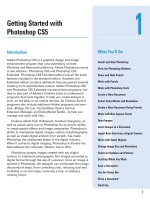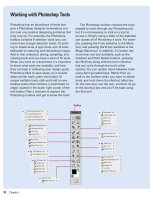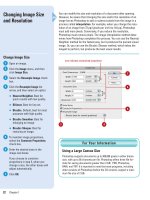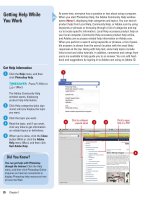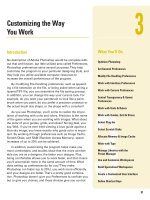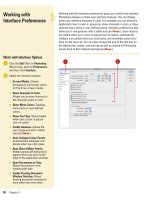Photoshop cs5 by steve Johnson part 24 docx
Bạn đang xem bản rút gọn của tài liệu. Xem và tải ngay bản đầy đủ của tài liệu tại đây (1.05 MB, 8 trang )
ptg
148 Chapter 7
Adjustment layers perform two functions—they adjust the image and
they give you control. Since an adjustment is held in a separate layer,
you have the advantage of isolating the adjustment and keeping your
original image information intact. Combine that with an adjustment
layer's ability to manipulate pixel information and you have a very pow-
erful image-editing tool. Blending Modes change how two or more
layers interact. For example, the Multiply blending mode instructs
Photoshop to mix the pixels of two or more layers, thus creating an
entirely new image from the mix. With that in mind, the five modes that
produce the most stunning results are Multiply, Screen, Hard Mix,
Difference, and Exclusion. The opacity of an adjustment layer controls
the intensity of the selected adjustment. You can reduce the opacity of
the Hue & Saturation adjustment to 50% and it would reduce its effect
on the image. Since each adjustment layer has its own opacity settings,
multiple adjustment layers can be fine-tuned to create a custom effect
on the image.
Using Blending
Modes and Opacity
with Layers
Use Blending Modes with
Adjustment Layers
Select the Layers panel.
Click the layer you want to adjust.
Click the Blending Mode list
arrow, and then select from the
available options.
The results of the blend are visible
in the document window.
3
2
1
1
2
3
Blending Mode change applied to image
From the Library of Wow! eBook
ptg
Chapter 7 Working with Adjustment Layers, Filters, and Tools 149
Control Through Opacity
Select the Layers panel.
Select the layers you want to
adjust.
You can apply opacity to one or
more (New!) selected layers in
the Layers panel.
Click the Opacity list arrow, and
then drag the slider to lower the
opacity of the layer.
The results of the change appear
in the document window.
TIMESAVER
Click inside the
Opacity box, and then use the Up
and Down Arrow keys to increase
or decrease the opacity 1
percentage point at a time. Hold
the Shift key, and then use the Up
and Down Arrow keys to increase
or decrease the opacity 10
percentage points at a time. You
can also select the percentage in
the box and enter a value.
3
2
1
1
2
3
The effect of lowering the
opacity of the layer by 50%
mutes the adjustment layer.
From the Library of Wow! eBook
ptg
150 Chapter 7
When you create an adjustment layer, the effects of the adjustment are
applied to the entire image. For example, if you use the Curves adjust-
ment, the resulting changes are applied to the entire image. It's true
you can modify the adjustment with the use of layer blending modes
and opacity settings but the effects are applied equally to the entire
image. The problem is that many times you don't want the adjustment
applied to the entire image. For example, you may want to color-correct
just a portion of the image, or lighten the shadows of an image without
applying the same lightening adjustment to the highlights. Photoshop
handles this problem with the use of masks. When you create an
adjustment layer, Photoshop automatically creates a mask with the
image. The mask controls how the adjustment is applied to the image,
and you control the effect by painting in the mask with black, white, or
a shade of gray. When you paint in the mask with black, it will totally
mask the adjustment; painting with white fully applies the adjustment. If
you paint with 50% gray, then the adjustment is applied to the image at
50% strength.
Using Masks with
Adjustment Layers
Paint on an Adjustment Mask
Select the Layers panel.
Click the layer mask thumbnail in
which you want to paint a mask.
Select a Paintbrush tool.
Select a brush size on the Options
bar.
Select the Masks panel to display
details about both pixel and vector
masks and select from options to
change the opacity (density) of the
mask, as well as feather options.
You can also access the Color
Range command from here and
invert the mask.
Set the Foreground Color box on
the toolbox to black as the paint
color.
Paint the areas of the image that
you want to mask. The adjustment
layer must be selected. The areas
painted black mask the adjustment,
returning the image to normal.
To re st ore the maske d areas,
switch to white and drag across
the image in the areas previously
painted black.
8
7
6
5
4
3
2
1
1
2
7
5
From the Library of Wow! eBook
ptg
Chapter 7 Working with Adjustment Layers, Filters, and Tools 151
You can create an instant mask using traditional selection techniques.
Before creating the adjustment layer, select the area of the image to
which you want the adjustment applied. Use any of Photoshop's selec-
tion tools for this purpose. When you create the adjustment layer,
Photoshop converts the selection into a mask, and only the selected
areas of the image are changed.
Creating Masks with
Selections
Create Masks with Selections
Use any of Photoshop's selection
tools to create a selection around
the area of the image to which you
want the adjustment applied.
Select the Layers panel.
Click the Create New Fill or
Adjustment Layer button, and then
select from the available
adjustments or use the new
Adjustments panel to choose one
of the adjustment icons.
Photoshop creates a mask based
on your selection with the
selected areas being adjusted and
the non-selected areas masked.
3
2
1
1
3
2
Did You Know?
You can use any of Photoshop's filters
on an adjustment layer mask.
For example, you could use the
Gaussian Blur filter to soften the edge
between adjustment and mask.
Experiment with different filters for
different creative effects.
From the Library of Wow! eBook
ptg
152 Chapter 7
The Add Noise filter applies random pixels to an image. When you want
to simulate a film grain effect, you can apply the Add Noise filter. For
example, you could use the Add Noise filter to make an image look like
it was taken using high-speed film. In addition, the Add Noise filter can
be used to reduce banding in feathered selections or graduated fills or
even give a more realistic look to heavily retouched areas. Experiment
with the Add Noise filter in combination with other filters, such as
Motion Blur filters, to create eye-catching special effects.
Using the Add
Noise Filter
Use the Add Noise Filter
Select the Layers panel.
Select the layer to which you want
to apply the Add Noise filter.
Click the Filter menu, point to
Noise, and then click Add Noise.
Select from the following options:
◆ Amount. Drag the slider, or
enter a value (0.10 to 400) to
increase or decrease the
amount of noise added to the
image.
◆ Distribution. Click the Uniform
option to create a more ordered
appearance, or click the
Gaussian option to create a
more random noise pattern.
◆ Monochromatic. Select this
check box to apply the filter to
the tonal elements in the image
without changing the colors.
TIMESAVER
The plus and
minus signs, located directly under
the image preview, let you
increase or decrease the viewable
area of the image.
Click OK.
5
4
3
2
1
5
4
Using Filters to Retouch an Image
One of Photoshop's most powerful features is its ability to recreate a
photographic image. Photographers use the term photographic
restoration to describe image retouching. Photo restoration
describes the process of returning an image to its original state. For
example, you could remove dust and scratches from an old image
using the Dust and Scratches filter, or repair other problems associ-
ated with old or damaged images using Photoshop filters. Since the
same tools and filters can be used to restore an image as you have
been using to apply effects to your images, you can experiment with
various filters to find out which ones will help you with your image
restoration.
For Your Information
From the Library of Wow! eBook
ptg
Chapter 7 Working with Adjustment Layers, Filters, and Tools 153
The Reduce Noise filter helps to remove the random noise that crops
up in digital images. It's called noise, but in reality it is a pattern of dis-
tracting color or grayscale information on top of the original image
information. Noise can be generated by the Add Noise filter, but it typi-
cally comes from scanners and even digital cameras. Since there is a
mathematical pattern to most noise, the Reduce Noise filter is designed
to seek out and reduce the amount of noise in an image. The Reduce
Noise filter works on individual layers, not the entire document. After
applying the filter, you can use other restoration tools, such as the
Healing Brush and Patch tool, to further clean up problem areas in your
image.
Using the Reduce
Noise Filter
Use the Reduce Noise Filter
Click the Filter menu, point to Noise,
and then click Reduce Noise.
Select the Preview check box to
view the changes to the image.
Select the Basic or Advanced
option. Advanced allows you to
adjust the noise on individual
channels.
Select from the following options:
◆ Settings. Click the setting arrow
and select a user-defined preset.
◆ Strength. Drag the slider to
determine how strong to apply
the Reduce Noise filter.
◆ Preserve Details. Drag the slider
to determine a balance between
blurring the noise and preserving
details.
◆ Reduce Color Noise. Drag the
slider to convert noise composed
of colors into shades of gray (this
may desaturate other areas of
the image).
◆ Sharpen Details. Drag the slider
to determine where the details of
the image exist, in terms of shifts
in brightness.
◆ Remove JPEG Artifact. Check to
help remove artifacts (typically
noise within shadows) from
severely compressed JPEG
images.
Click OK.
5
4
3
2
1
5
3
4
Noise filter applied
to the image
From the Library of Wow! eBook
ptg
154 Chapter 7
Vanishing Point gives you the ability to move and/or copy objects and
still maintain the same visual perspective of the original. Let's say that
you shoot an image of a roadway disappearing into the distance, and
along the road there's a billboard. You want the billboard to appear as if
it's farther away, but to retain its proper perspective within the image.
With Vanishing Point, you simply create a framework, or plane, that
identifies the depth of the image, and then move the billboard (using the
Move or Clone Stamp tools). Wherever you move the sign, it will appear
within the proper perspective. If you have Photoshop Extended, you
can adjust the angle of the plane for greater flexibility or take measure-
ments. When you finish working in Vanishing Point, you can use the
Vanishing Point menu to render grids to Photoshop. With Photoshop
Extended, you can also export 3D information and measurements to
DXF or 3DS formats.
Keeping Proper
Perspective with
Vanishing Point
Use the Vanishing Point Tool
Open an image.
Click the Filter menu, and then
click Vanishing Point.
The following tools are available:
◆ Edit Plane. Adjusts the grid to
match the perspective of the
image.
◆ Create Plane. First tool to use;
it creates the initial perspective
grid plane.
◆ Marquee Tool. Makes
selections in the grid and then
changes their perspective as
you move them to match the
perspective of the grid.
◆ Stamp Tool. Lets you make
copies of areas and then stamp
them onto other areas using the
perspective of the grid.
◆ Brush Tool. Lets you paint with
color within the grid. If you
click the Heal button and then
click Luminance, Vanishing
Point adapts the color to the
shadows or textures of the
areas being painted.
◆ Transform Tool. Lets you rotate,
resize or flip a selection
created with the Marquee tool.
◆ Eyedropper Tool. Click to select
a specific color from the image.
3
2
1
Edit Plane
Marquee
Brush
Eyedropper
Hand
Create
Plane
Stamp
Transform
Measure
1
Zoom
Vanishing Point
menu
11
From the Library of Wow! eBook
ptg
Chapter 7 Working with Adjustment Layers, Filters, and Tools 155
◆ Measure Tool. Lets you draw a
measurement line over an
object in a perspective plane
(Extended).
◆ Hand Tool. Click to move the
image within the Vanishing
Point window.
◆ Zoom Tool. Click to Zoom in, or
Alt+click (Win) or Option+click
(Mac) to zoom out.
Select the Create Plane tool.
Click on the image to create the
first point of the grid, and then
click three more times to create
the box shape of the grid.
◆ Angle. Lets you adjust the
plane angle (Extended).
Use the Edit Plane tool to change
the perspective of the plane, and
to extend the plane over the area
you want fixed.
The grid should be blue; however,
if the grid turns red or yellow, that
means Vanishing Point believes
you have a bad grid.
Select the Zoom tool, and zoom in
on the working areas of the image.
Select the Stamp tool.
Position the Stamp tool directly
over the image area you want to
use to fix the offending portions of
the image, and then Alt+click
(Win) or Option+click (Mac) to
confirm the selection.
Move to the area you want to fix
and then click and drag with the
Stamp tool, which replaces the
original information; the perspec-
tive changes to match the grid.
To sh ow the grid in Photosh op,
click the Vanishing Point menu,
and then click Render Grids To
Photoshop.
Click OK.
12
11
10
9
8
7
6
5
4
5
6
9
10
7
Edit
Plane
8
4
From the Library of Wow! eBook
